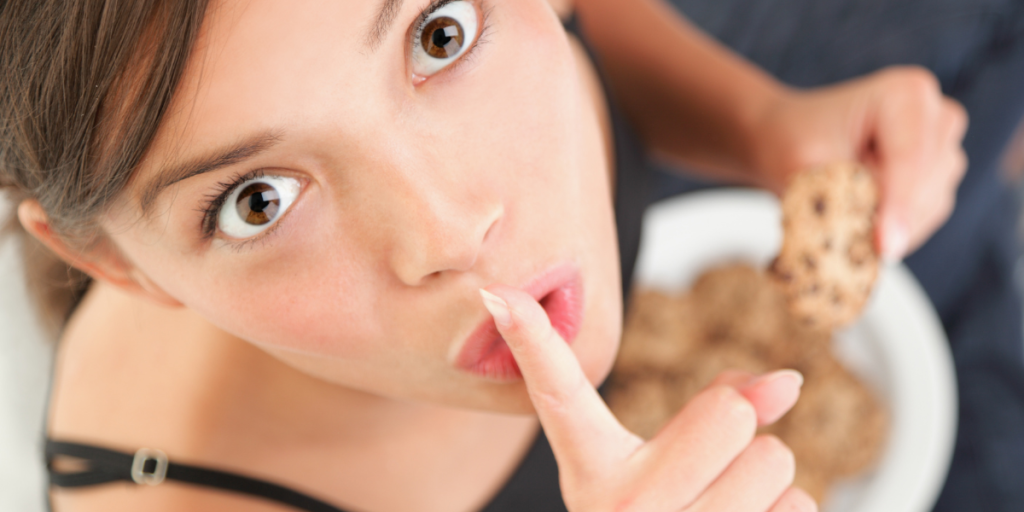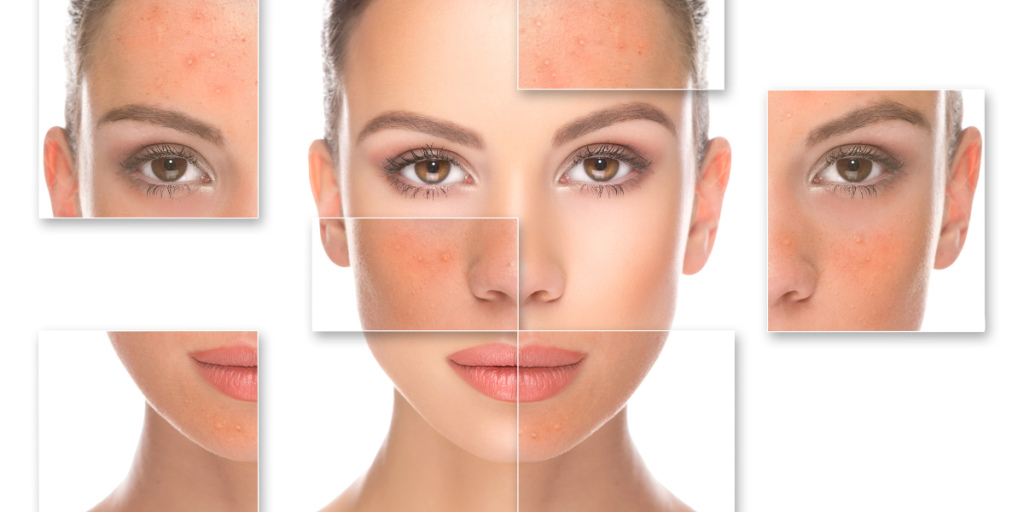While nearly everyone has heard of eating disorders, not everyone has heard of body dysmorphic disorder (BDD) and disordered eating, let alone the 10 things they have in common. Are these all variations of the same thing, or do the semantics matter in identifying and treating these disorders?
I’m going to list them here :
- body dysmorphic disorder
- disordered eating
- eating disorders

These three disorders conceptually mush together as “body hatred coupled with dysfunctional eating.”
They all have the word ‘disorder’ in them, two have the word ‘eating’ in them, and one has the word ‘body’ in it. Isn’t this much ado about the same thing?
Short answer: no.
While clinical terminology can be a mouthful of marbles, it really is based in clarity.
This article is going to focus on body dysmorphic disorder (BDD) and disordered eating. (For an introduction to eating disorders, read here.)
It’s helpful to know in advance that, while there are differences across the board, there are also plenty of similarities. And yes, the overlap creates a lot of gray area, even for us professionals who treat people with these disorders.
First, let’s get familiar with BDD and disordered eating separately. Then we’ll look at what they have in common, and how they both increase the risk for eating disorders.
Body Dysmorphic Disorder: Preoccupation with (Mis)Perception

If we were writing answers for Jeopardy, body dysmorphic disorder (BDD), also called body dysmorphia, might be summed up as follows:
- A preoccupation with a perceived flaw in appearance – a flaw that doesn’t exist or is barely noticeable to others.
- Intense focus on the perceived flaw for several hours a day – checking mirrors, body-checking, grooming, and so on.
- Compulsive behaviors aimed at correcting or annihilating the perceived flaw.
- Anxiety and distress about the flaw and therefore social avoidance and diminished daily functioning.
While BDD and disordered eating (and, at the far end of the spectrum, eating disorders) have similarities, BDD has at least one distinction.
BDD isn’t necessarily focused on body size, weight, or “fatness.” And it doesn’t necessarily include impaired eating in its arsenal of “corrective” behaviors.

As a matter of fact, the most common areas of BDD preoccupation are:
- Face (nose, complexion, wrinkles, acne, birthmarks)
- Hair (thinness, balding)
- Skin and veins
- Muscle size (muscle dysmorphia, or concern with body build, is especially present in men)
- Genitalia
Social media and shows like Botched have a way of normalizing dysmorphic thinking.
Although Drs. Nassif and Dubrow play heroes who swoop in and repair past cosmetic-surgery disasters, the seed of dysmorphia has been planted.
Not only does the show draw attention to the downward spiral of chasing imagined perfection, it makes entertainment of it. Kylie Jenner lips? Yes, of course. Barbie’s partial-rib cage waistline? Probably not wise…but hey, let’s show your story so viewers know the “ideas” that people (and doctors) are trying to manifest.
With regard to treatment, BDD is especially responsive to cognitive behavioral therapy (CBT) and medication, usually selective serotonin reuptake inhibitors (SSRIs).
Disordered Eating: Description, Not Diagnosis
OK, let’s tackle the obvious: “Disordered eating” and “eating disorder” sound like they’re two ways of saying the same thing.
But they’re not.
The most important difference between the two lies in the very specific and narrow criteria defined by the American Psychiatric Association for eating disorders.
Disordered eating is a behavioral description. An eating disorder, on the other hand, is a very specifically defined mental health diagnosis.
This is not to say that disordered eating can’t lead to or be symptomatic of an eating disorder. But too often those who are uninformed jump to a speculative eating disorder diagnosis based on disordered eating behaviors.
So, for purposes of general understanding and comparison, disordered eating is the broader category and eating disorders are the narrowly defined diagnosis.
What does disordered eating look like? Most people would be surprised to find some of their own behaviors – past or present – in the list.

- Yo-yo dieting
- Frequent weight fluctuations
- Rigid rituals and routines around food and exercise
- Avoiding or limiting specific foods (sweets, carbs, bread – sigh, the bread)
- Feelings of guilt or shame associated with eating
- Anxiety associated with specific foods
- Preoccupation with food, weight, body size, and body image that negatively impacts life
- Using exercise, food restriction, fasting, or purging to make up for eating “bad” foods (read here to learn about purging disorder vs. bulimia)
By now you’re probably catching on to the amount of overlap among eating concerns like eating disorders, BDD, and disordered eating.
And that should shed light on the need to take all body image issues and disordered eating behaviors seriously.
Body Dysmorphic Disorder and Disordered Eating: Similarities with the Quest for Perfection
At the heart of both BDD and disordered eating is a body image crisis.
Everyone has a relationship with his or her own body and therefore has a ‘body image.’

That body image has 4 aspects:
- Perceptual body image: how you see your body
- Affective body image: how you feel about your body
- Cognitive body image: how you think about your body
- Behavioral body image: how you behave as a result of your body image
Although body dysmorphia tends to focus on areas like the face and skin, it can also focus on body shape and size.
And this body dissatisfaction is where we see similarities between BDD and disordered eating.
Here are 10 similarities between body dysmorphic disorder (BDD) and disordered eating:
- A negative preoccupation with the body or part(s) of the body
- An obsession with trying to correct the area of dissatisfaction
- A disruption of normal daily functioning because of time spent focused on the negative preoccupation
- Avoidance of social situations because of the belief that others will see and judge the “flawed” area(s)
- Rigid or compulsive rituals around eating and exercising in order to fix the “unacceptable” body area(s)
- Diminished self-esteem
- Anxiety, shame, guilt, and disappointment when the desired result doesn’t happen
- Heightened risk of developing an eating disorder
- Influence of social media
- Treatability
As you can see, these similarities can be fully applied to either BDD or disordered eating.
The “flaw” of preoccupation could just as easily be fat around the belly as a slightly crooked nose. It could be an endomorphic build just as easily as a thinning hairline.
And the time spent trying to “fix” the perceived or exaggerated flaw can be as consuming with rigid eating rituals as with body-checking or grooming.
The inevitable result? A disruption and diminishment of life – personally, relationally, socially, professionally.
Again, a negative body image that oozes dissatisfaction and lack of self-acceptance is at the heart of both BDD and disordered eating.
Granted, neither body image concern may present with enough specific criteria to meet the APA guidelines for an eating disorder. But they both need to be taken seriously.
There are, after all, enough gray areas between the three to pose a risk of passing through the gray into something more dangerous.

The cautionary takeaway here is that having a positive body image isn’t just “nice” to have. It’s critical.
The alternative – a negative, judgmental, dissatisfied, unaccepting self-perception – is diminishing to mind, body, and spirit.
The irony? The inherent pursuit of body dysmorphia and disordered eating is to achieve the opposite of that negativity. It’s to achieve what social media, Diet Culture, and societal standards would have us all believe comes along with looking a certain way.
But the promise, as everyone who buys into it comes to learn, is completely empty.
In the end, you don’t have to be in love with your body. Whether it’s a midline crisis, splotched reminders of reckless sunbathing, or a coveted Herculean build that’s never going to happen, neutrality is perfectly fine.

The core objective in treating BDD and disordered eating is to (re)establish a healthy relationship with one’s body. To see differently and ultimately feel, think, and behave differently.
And that starts with embracing – unequivocally – that one’s value is not dependent on the body, and happiness isn’t dependent on appearances.
